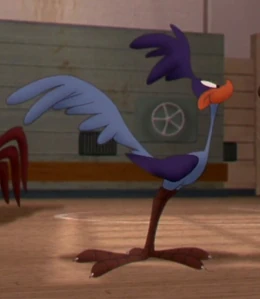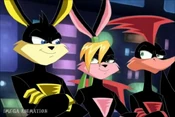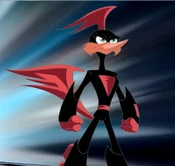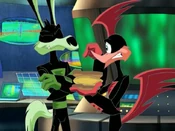| Road Runner | |
|---|---|
 | |
|
Gender |
Male |
|
First Appearance |
|
|
Team |
|
|
Voice Actors |
|
Road Runner is the fastest bird on earth, and he is always one step ahead of the ravenous Wile E. Coyote. He and the Coyote are from a series of Looney Tunes and Merry Melodies cartoons. The characters a coyote and the Road Runner were created by animation director Chuck Jones in 1948 for Warner Bros., while the template for their adventures was the work of writer Michael Maltese. The characters star in a long-running series of theatrical cartoon shorts the first 16 of which were written by Maltese and occasional made-for-television cartoons.
In each episode, instead of animal senses and cunning, Wile E. Coyote uses absurdly complex contraptions sometimes in the manner of Rube Goldberg and elaborate plans to pursue his quarry. It was originally meant to parody chase cartoons like Tom and Jerry, but became popular in its own right.
To date, 48 cartoons have been made featuring these characters including the three CGI shorts, the majority by Chuck Jones.
Creation[]
Jones based the Coyote on Mark Twain's book Roughing It, in which Twain described the coyote as "a long, slim, sick and sorry-looking skeleton" that is "a living, breathing allegory of Want. He is always hungry." Jones said he created the Coyote-Road Runner cartoons as a parody of traditional "cat and mouse" cartoons such as MGM's Tom and Jerry, which Jones would work on as a director later in his career. Jones modelled the Coyote's appearance on fellow animator Ken Harris.
The Coyote's name of Wile E. is a play on the word "Wile." The "E" was said to stand for Ethelbert in one issue of a Looney Tunes comic book, but its writer had not intended it to be canon. The Coyote's surname is routinely pronounced with a long "e" (/kaɪˈoʊtiː/ ky-oh-tee), but in one cartoon short, to hare is human, Wile is heard pronouncing it with a diphthong (/kaɪˈoʊteɪ/ ky-oh-tay). Early model sheets for the character prior to his initial appearance (in fast and Furry-ous) identified him as "Don Coyote", a play on Don Quixote.
Scenery[]
The desert scenery in the first two Road Runner cartoons, fast and Furry-ous (1949) and Beep, Beep (mid-1950), was designed by Robert Gribbroek and was quite realistic. In most later cartoons the scenery was designed by Maurice Noble and was far more abstract. Several different styles were used. In The Wild Chase (1964), featuring a race between the Road Runner and Speedy Gonzales, it is stated that the Road Runner is from Texas, insofar as the race announcer calls him the "Texas Road Burner." That suggests that most of the Wile E. and Road Runner cartoons could take place in texas. However, in To Beep or Not to Beep, the catapult is constructed by the Road-Runner Manufacturing Company, which has locations in Taos, Phoenix, Santa Fe, and Flagstaff, suggesting that it takes place in or near the Four Corners (Arizona, New Mexico, Utah, Colorado) region, specifically Monument Valley.
In Going! Going! Gosh! (late 1951) through Guided Muscle (late 1954) the scenery was "semi-realistic" with an off white sky (possibly suggesting overcast/cloudy weather condition). Gravity-defying rock formations appeared in Ready, Set, Zoom! (early 1954). A bright yellow sky made its debut in Gee Whiz-z-z-z-z-z-z (early 1955) but was not used consistently until they Go-Go-Go!, later in the same year.
Zoom and Bored (late 1956) introduced a major change in background style. Sharp, top-heavy rock formations became more prominent, and warm colors (yellow, orange, and red) were favored. Bushes were crescent-shaped. Except for Whoa, Be-Gone! (early 1957), whose scenery design harked back to Guided Muscle in certain aspects (such as off-white sky), this style of scenery was retained as far as Fastest with the Mostest (early 1959). Hopalong Casualty (mid–1959) changed the color scheme, with the sky reverting to blue, and some rocks becoming off-white, while the bright yellow desert sand color is retained, along with the 'sharp' style of rock formations pioneered by Zoom and Bored. The crescent shapes used for bushes starting with Zoom and Bored were retained, and also applied to clouds. In the last scene of War and Pieces (1963), Wile E. Coyote's rocket blasts him through the center of the earth to china, which is portrayed with abstract Oriental backgrounds.
The Format Films cartoons used a style of scenery similar to Hopalong Casualty and its successors, albeit less detailed and with small puffy clouds rather than crescent-shaped ones.
Freeze Frame, a made-for-television short originally shown as part of the 1979 CBS special Bugs Bunny's Looney Christmas Tales, depicts the Road Runner taking a turn that leads the chase into mountains and across a wintry landscape of ice and snow.
Laws and rules[]
As in other cartoons, the Road Runner and the coyote follow the laws of cartoon physics. For example, the Road Runner has the ability to enter the painted image of a cave, while the coyote cannot (unless there is an opening through which he can fall). Sometimes, however, this is reversed, and the Road Runner can burst through a painting of a broken bridge and continue on his way, while the Coyote will instead enter the mirage painting and fall down the precipice of the cliff where the bridge is out. Sometimes the coyote is allowed to hang in midair until he realizes that he is about to plummet into a chasm (a process occasionally referred to elsewhere as Road-Runnering or a Wile E. Coyote moment). The coyote can overtake rocks (or cannons) which fall earlier than he does, and end up being squashed by them. If a chase sequence runs over the edge of a cliff, the Road Runner is not affected by gravity, whereas the Coyote will realize his error eventually and fall to the ground below.
A chase sequence that happens upon railroad tracks will always result in the Coyote being run over by a train. If the Coyote uses an explosive (for instance, dynamite) that is triggered by a mechanism that is supposed to force the explosive in a forward motion toward its target, the actual mechanism itself will always shoot forward, leaving the explosive behind to detonate in the Coyote's face. Similarly, a complex apparatus that is supposed to propel an object like a boulder or steel ball forward, or trigger a trap, will not work on the Road Runner, but always will on the Coyote. For instance, the Road Runner can jump up and down on the trigger of a large animal trap and eat bird seed off from it, going completely unharmed and not setting off the trap; when the Coyote places the tiniest droplet of oil on the trigger, the trap snaps shut on him without fail. At certain times, the Coyote may don an exquisite Acme costume or propulsion device that briefly allows him to catch up to the Road Runner. This will always result in him losing track of his proximity to large cliffs or walls, and the Road Runner will dart around an extremely sharp turn on a cliff, but the Coyote will rocket right over the edge and fall to the ground.
In his book Chuck Amuck: The Life and Times of an Animated Cartoonist, Chuck Jones claimed that he and the artists behind the Road Runner and Wile E. cartoons adhered to some simple but strict rules:
- The Road Runner cannot harm the Coyote except by going "beep, beep."
- No outside force can harm the Coyote — only his own ineptitude or the failure of Acme products. Trains and trucks were the exception from time to time.
- The Coyote could stop anytime — if he were not a fanatic. (Repeat: "A fanatic is one who redoubles his effort when he has forgotten his aim." — George Santayana).
- Dialogue must never be used, except "beep, beep" and yowling in pain. (This rule, however, was violated in some cartoons.)
- The Road Runner must stay on the road — for no other reason than that he's a roadrunner. This rule was broken in Beep, Beep, in a sequence where Wile E. chased the Road Runner into a cactus mine. And also in Fastest with the Mostest when Coyote lures Road Runner to the edge of a cliff.
- All action must be confined to the natural environment of the two characters — the southwest American desert.
- All (or at least almost all) tools, weapons, or mechanical conveniences must be obtained from the Acme Corporation. There were sometimes exceptions when the Coyote obtained other items from the desert such as boulders to use in his attempts.
- Whenever possible, make gravity the Coyote's greatest enemy (e.g., falling off a cliff).
- The Coyote is always more humiliated than harmed by his failures.
- The audience's sympathy must remain with the Coyote.
- The Coyote is not allowed to catch or eat the Road Runner, unless he escapes from the grasp. (The robot that the Coyote created in the Solid Tin Coyote caught the Road Runner so this does not break this rule. The Coyote does catch the Road Runner in Soup or Sonic but is too small to eat him. There are also two CGI shorts on The Looney Tunes Show where he caught the bird, but was not able to eat him because the Road Runner got away in both shorts.)
In an interview years after the series was made, writer Michael Maltese said he had never heard of the "Rules."
Later cartoons[]
The original Chuck Jones productions ended in 1963 after Jack Warner closed the Warner Bros. animation studio. War and Pieces, the last Road Runner short directed by Jones, was released in mid-1964. By that time, David DePatie and veteran director Friz Freleng had formed DePatie-Freleng Enterprises, moved into the facility just emptied by Warner, and signed a license with Warner Bros. to produce cartoons for the big studio to distribute.
Their first cartoon to feature the Road Runner was the Wild Chase, directed by Freleng in 1965. The premise was a race between the bird and "the fastest mouse in all of Mexico," Speedy Gonzales, with the Coyote and Sylvester each trying to make a meal out of his usual target. Much of the material was animation rotoscoped from earlier Runner and Gonzales shorts, with the other characters added in.
In total, DePatie-Freleng produced 14 Road Runner cartoons, two of which were directed by Robert McKimson (Rushing Roulette, 1965, and Sugar and Spies, 1966). Due to cuts in the number of frames used per second in animated features, many of these final Road Runner features were cheap looking and jerky. Also, the music was very different and of poorer quality than the older features. That was disappointing to fans of the original shorts, and many felt it was the final death knell for animation.
The remaining eleven were subcontracted to Format Films and directed under ex-Warner Bros. animator Rudy Larriva. The "Larriva Eleven", as the series was later called, lacked the fast-paced action of the Chuck Jones originals and was poorly received by critics. In Of Mice and Magic, Leonard Maltin calls the series "witless in every sense of the word." In addition, except for the planet Earth scene at the tail end of "Highway Runnery", there was only one clip of the Coyote's fall to the ground, used over and over again. These cartoons can easily be distinguished from Chuck Jones' cartoons, because they feature the modern "Abstract WB" Looney Tunes opening and closing sequences, and they use the same music cues over and over again in the cartoons, composed by William Lava. Only one of those eleven cartoons — "Run, Run, Sweet Road Runner" — had music that was actually scored instead of the same music cues. Another clear clue is that Jones' previously described "Laws" for the characters were not followed with any significant fidelity, nor were there Latin phrases used when introducing the characters.
Other appearances[]
In the 1962 pilot for a proposed television series (but instead released as a theatrical featurrette titled Adventures of the Road-Runner — when the project failed as TV pilot, it was re-edited into To Beep or Not to Beep by Chuck Jones with additional new music by Bill Lava. But few years later reedited again into Zip Zip Hooray! and Road Runner a Go-Go, by DePatie-Freleng Enterprises).
Chuck Jones' 1979 film The Bugs Bunny/Road Runner Movie features Jones' characters, including Wile E. Coyote and Road Runner. However, whereas most of the featured cartoons are single cartoons or sometimes isolated clips, the footage of Wile E. Coyote and Road Runner is taken from several different cartoons and compiled to run as one extended sequence.
Wile E. Coyote and the Road Runner have two cameo roles in Robert Zemeckis' Who Framed Roger Rabbit first silhouetted when the elevator maneuvered by Droopy goes up, and then during the final scene in Marvin Acme's factory with several other Looney Tunes and other studio characters.
Wile E. Coyote and the Road Runner appear as members of the Tune Squad team in Space Jam. There, Wile E. rigs one of the basketball hoops with dynamite to prevent one of the Monstars from scoring a slam dunk. And during practice before Lola Bunny shows up, Wile E. Coyote gets his hands on a basketball, but the Road Runner steals the ball from him, and heads into a painted image. But Wile E. doesn't know it's a painted image, and he runs right into it.
The two appeared in many different advertisements for Shell, Honey Nut Cheerios and Wile E. appears without the bird in adverts for the Energizer Bunny. In 2012, both Wile E Coyote and Road Runner appeared in a GEICO commercial, in which the wandering gecko is lost. While he is doing so, he nearly gets crushed with an anvil, and then a piano. Just after this happens, Road Runner runs up to him, says his trademark phrase, "Beep beep!" and goes on his way. Then, Wile, chasing the Road Runner, runs up, sees the gecko and imagines him as his dinner, but while doing so, is driven into the ground by a falling Acme safe. The commercial ends with the gecko concluding, "What a strange place."
The Road Runner is the mascot for a brand of ice melt by Scotwood Industries.
The two also appeared in the webtoons "Wild King Dumb" and "Judge Granny: Case 2" on looneytunes.com.
Television[]
The Road Runner and the Coyote appeared on Saturday mornings as the stars of their own TV series, The Road Runner Show, from September 1966 to September 1968, on CBS. At this time it was merged with The Bugs Bunny Show to become The Bugs Bunny and Road Runner Show, running from 1968 to 1985. The show was later seen on ABC until 2000, and on Global until 2001.
In the 1970s, Chuck Jones directed some Road Runner short films for the educational children's TV series The Electric Company. These short cartoons used the Coyote and the Road Runner to display words for children to read, but the cartoons themselves are a refreshing return to Jones' glory days.
In 1979, Freeze Frame, in which Jones moved the chase from the desert to snow covered mountains, was seen as part of Bugs Bunny's Looney Christmas Tales.
At the end of Bugs Bunny's Portrait of the artist as a Young Bunny (the initial sequence of Chuck Jones' TV special, Bugs Bunny's Bustin' Out All Over), Bugs mentions to the audience that he and Elmer may have been the first pair of characters to have chase scenes in these cartoons, but then a pint-sized baby Wile E. Coyote (wearing a diaper and holding a small knife and fork) runs right in front of Bugs, chasing a gold-colored, mostly unhatched (except for the tail, which is sticking out) Road Runner egg, which is running rapidly while some high-pitched "beep, beep" noises can be heard. This was followed by the full-fledged Runner/Coyote short, Soup or Sonic. Earlier in that story, while kid Elmer was falling from a cliff, Wile E. Coyote's adult self tells him to move over and leave falling to people who know how to do it and then he falls, followed by Elmer.
In the 1980s, ABC began showing many Warner Bros. shorts, but in highly edited form, because the unedited versions were supposedly too violent. Many scenes integral to the stories were taken out, including scenes in which Wile E. Coyote landed at the bottom of the canyon after having fallen from a cliff, or had a boulder or anvil actually make contact with him. In almost all WB animated features, scenes where a character's face was burnt and black, resembling blackface, were removed, as were animated characters smoking cigarettes, or even simulated cigarettes. Some cigar smoking scenes were left in. The unedited versions of these shorts (with the exception of ones with blackface) were not seen again until Cartoon Network, and later Boomerang, began showing them again in the 1990s and early 2000s. Since the release of the WB library of cartoons on DVD, Boomerang has stopped showing the cartoons, presumably to increase sales of the DVDs.
Wile E. and the Road Runner later appeared in several episodes of Tiny Toon Adventures. In this series, Wile E. (voiced in the Jim Reardon episode "Piece of Mind" by Joe Alaskey) was the dean of Acme Looniversity and the mentor of Calamity Coyote. The Road Runner's protégé in this series was Little Beeper. In the episode "Piece of Mind", Wile E. narrates the life story of Calamity while Calamity is falling from the top of a tall skyscraper. In the direct-to-video film Tiny Toon Adventures: How I Spent My Vacation, the Road Runner finally gets a taste of humiliation by getting run over by a mail truck that "brakes for coyotes."
The two were also seen in cameos in Animaniacs. They were together in two "Slappy Squirrel" cartoons: "Bumbie's Mom" and "Little Old Slappy from Pasadena". In the latter the Road Runner gets another taste of humiliation when he is outrun by Slappy's car, and holds up a sign saying "I quit" — immediately afterward, Buttons, who was launched into the air during a previous gag, lands squarely on top of him. Wile E. appears without the bird in the Wizard of Oz parody, dressed in his batsuit from one short, in a twister (tornado) funnel in "Buttons in Ows". Also, in the beginning of one episode, an artist is seen drawing Road Runner.
Wile E. and Road Runner appeared in their toddler versions in Baby Looney Tunes, only in songs. However, they both had made a cameo in the episode, "Are We There Yet?", where Road Runner was seen out the window of Floyd's car with Wile E. chasing him.
Road Runner appears in an episode of the 1990 series Taz-Mania in which Taz grabs him by the leg and gets ready to eat him until the two gators are ready to capture Taz so he lets Road Runner go. In another episode of Taz-Mania the Road Runner cartoons are parodied with Taz dressed as Road Runner and the character Willy Wombat dressed as Wile E. Coyote. Willy tries to catch Taz with Acme Roller Skates but fails, and Taz even says "Beep, beep".
Loonatics Unleashed[]
In Loonatics Unleashed, Wile E. Coyote and Roadrunner's 28th century descendants are Tech E. Coyote and Rev Runner. Tech E. Coyote was the tech expert of the Loonatics (influenced by the past cartoons with many of the machines ordered by Wile E. from Acme), and has magnetic hands and the ability to molecularly regenerate himself (influenced by the many times in which Wile E. painfully failed to capture Roadrunner and then was shown to have miraculously recoveed).
Tech E. Coyote speaks, but does not have a british accent as Wile E. Coyote did. Rev Runner is also able to talk, though extremely rapidly, and can fly without the use of jet packs, which are used by other members of the Loonatics. He also has super speed, also a take off of Roadrunner. Ironically, the pair get on rather well, despite the number of gadgets Tech designs in order to stop Rev talking.
Also they have their moments where they don't get along. When friendship is shown it is often only from Rev to Tech, not the other way around; this could however be attributed to the fact that Tech has only the bare minimum of social skills.
They are both portrayed as smart, but Tech is the better inventor and at times Rev was shown doing stupid things. References to ancestor's past are seen in the episode "Family Business" not appear. Where the other Runners are wary of Tech and Tech relives the famous falling gags done in Coyote/Runner shorts.
The Looney Tunes Show[]
Road Runner and Wile E. feature in 3D computer animated cartoons or cartoon animation in Cartoon Network's new TV series The Looney Tunes Show.
The CGI shorts were only included in season one but Wile E. and Road Runner will still appear throughout the series in 2D animation.
3-D shorts[]
The characters are scheduled to appear in seven 3-D short attached to Warner Bros. features. Three have been screened with features, while the rest serve as segments in season one of The Looney Tunes Show.




